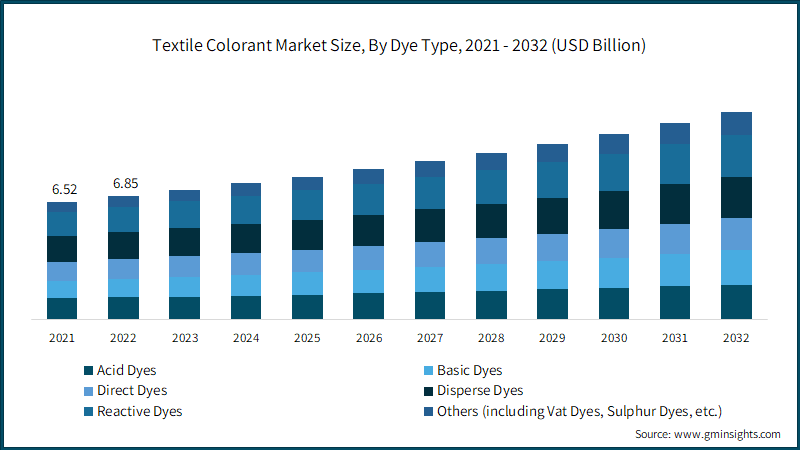Home > Chemicals & Materials > Specialty Chemicals > Textile Colorant Market
Textile Colorant Market Analysis
- Report ID: GMI7500
- Published Date: Nov 2023
- Report Format: PDF
Textile Colorant Market Analysis
Based on dye type, the market is segmented as acid dyes, basic dyes, direct dyes, disperse dyes, reactive dyes and others. Disperse dyes held a majority market value of USD 1.48 billion in 2022. Disperse dyes, essential for coloring synthetic fibers such as polyester, dominate a considerable segment of the market, reflecting the widespread use of these materials in the textile industry. Reactive dyes, preferred for their ability to bond chemically with cellulosic fibers, command a significant market share, particularly in the production of cotton textiles, owing to their excellent colorfastness.

Based on pigment type, the market is segmented as organic pigments and inorganic pigments. Inorganic pigments held a dominant market share of around 56.17% in 2022 and is expected to grow at a lucrative pace through 2032. Inorganic pigments contribute significantly to the market, boasting a diverse range of colors and high resistance to light and heat. Widely utilized for coloring textiles made from synthetic fibers such as polyester, inorganic pigments have gained prominence in industries where robustness and stability are crucial factors. The market share of inorganic pigments reflects their efficacy in applications where resistance to environmental factors and harsh conditions is paramount.
Based on end-user industry, the market is segmented as textile and apparel industry, home furnishing industry, automotive industry, healthcare industry and others. Textile and Apparel industry held the dominant market in 2022 and is anticipated to grow through the years. The demand for a broad spectrum of colors and innovative dyeing techniques in fabrics and garments fuels the market's growth. Additionally, the home furnishing industry is a significant player, leveraging colorants to enhance the aesthetic appeal of textiles used in furnishings such as upholstery, curtains, and bedding.

North American region dominated the market with majority market share and a revenue of USD 2.23 billion in 2022 and is anticipated to expand at a significant pace from 2023-2032. The United States and Canada are key contributors to this market share, boasting a well-established textile sector that demands a diverse range of colorants for fabrics, garments, and other applications. North America's market share is influenced by the region's proclivity for innovation and adoption of cutting-edge technologies in the textile industry. The demand for high-performance colorants that align with stringent environmental regulations and consumer preferences for sustainable products has driven the market toward eco-friendly and bio-based colorant solutions.

